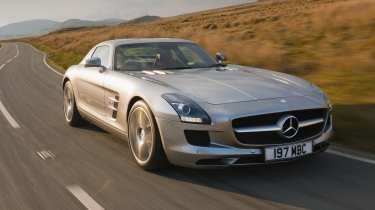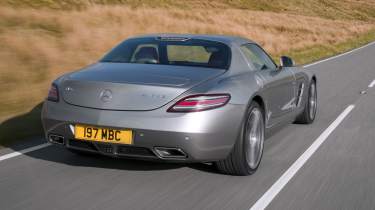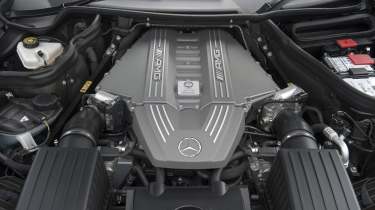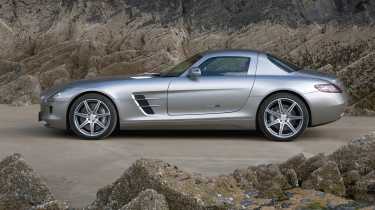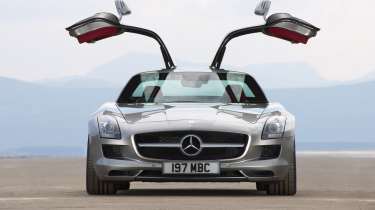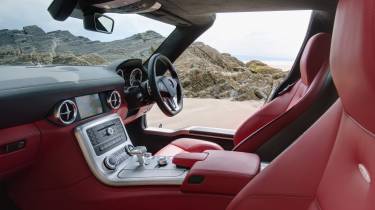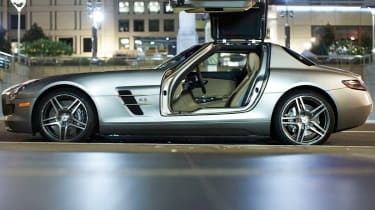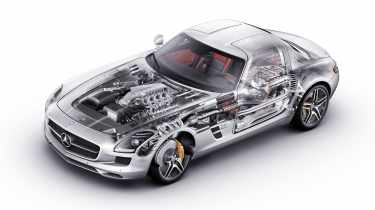Mercedes-Benz SLS AMG (2010 - 2015): Germany's answer to the Ferrari 599
The Mercedes-Benz SLS is a fully bespoke supercar that’s a slice of purest AMG
There is no doubt that the SLS is a bona fide modern classic. Its 300 SL-inspired design has proven timeless, while the car’s character is the absolute pinnacle of old-school AMG: unnecessary tech and electrical assistance are nowhere to be found and the naturally aspirated V8 still sits among the finest of its kind.
Based on the M156 unit of the CLK63 and W204 C63, the SLS’s M159 adopted a new intake system, modified valvetrain, new camshafts, revised headers, and even a dry-sump lubrication system to allow for a lower centre of gravity. The result was a peak output of 563bhp in its original form, which made it the most powerful naturally aspirated production engine of its time. While the SLS proudly wears the same ‘6.3’ badge as its M156-powered relatives, it too really has a displacement of 6.2 litres, 6.3 being a reference to the capacity of AMG’s very first V8, the M100.
> Mercedes-Benz C63 AMG (W204, 2008-2014): review, specs and buying guide
Paired with the same Getrag seven-speed dual-clutch transmission as found in the Ferrari 458 (albeit in a different state of tune), the result is a quoted 3.9sec 0-62mph time and 197mph top speed, ensuring the SLS remains a rapid car even 14 years on from its launch. Keen to reach its 7200rpm red line and incredibly responsive, it’s a powerplant like few others. The fact that AMG still produces the M159 solely for use in its successful Mercedes‑AMG GT3 racer is a good indicator of its strength.
More reviews
While its long, imposing bonnet might seem intimidating at first sight, the SLS is a truly useable car once behind the wheel, with its steering light yet direct. Henry Catchpole referred to its dynamics as ‘almost like those of a very big Caterham’ during our first drive, which may sound a stretch for a 1620kg super-GT, but it goes to show just how much AMG can achieve when given free rein (the SLS was its very first ground-up model).
What to look out for
Owners have reported very few issues, with only the occasional gremlin in the dual-clutch transmission to note – a software flash often fixes these problems, and recalls and dealership fixes are likely to have rectified these issues under prior owners. While the M159 does share the camshaft adjuster wear issue of its M156 relative, the frequency at which most SLSs are used means you’re unlikely to run into this issue any time soon (the first symptoms of wear usually appear at around 60,000 miles).
The key to ensuring longevity is to ensure the servicing schedule is adhered to (every year or every 10,000 miles, whichever comes first) and that the oil’s replenished with the correct grade. Given the performance on offer servicing costs are relatively reasonable and can be undertaken at any Mercedes dealership as well as specialists with Star diagnostic equipment.
As with the engine the major transmission component, the Speedshift dual-clutch ’box, is proving to be remarkably trouble free. The DCT itself is a version of the Getrag twin-clutch transaxle also used in the Ferrari 458 and California with specific AMG calibration and a carbonfibre propshaft to connect it to the V8.
Despite its robust nature ensure the DCT works properly when on a test drive – in auto mode it should be pretty seamless. In manual mode changes can be a little harsher so fully check the steering wheel paddles work properly on both up and down changes and in each of its modes. Enhanced factory AMG software is available and it’s a definite plus if a potential purchase has had this upgrade carried out.
Replacement clutches are expensive – several thousand pounds – but wear and life left can be checked by diagnostics which would be wise to look at. Some clutch glitches can be resolved by the updated software or by resetting the clutch positioning sensors.
As you’d expect with an aluminium machine there should be no corrosion issues. Do, however, check the alignment and operation of those gullwing doors if you’re looking at a coupe as they’re notoriously hard to align. Carry out the normal checks for accident damage, examining panel gaps and colour matching between panels carefully and while you’re at it have a look for stone chips on the nose and sills.
Inside take your time to check that all the electronic components work properly as repairing non-functioning items will be expensive. Ensure all the electronics work and there are no warning lights, as rectification can be extremely costly. Lastly, if you’re somewhat vertically challenged do make sure you can reach the door pull to close the gullwing door from the driver’s seat...
What to pay
SLS prices vary drastically depending on whether you’re looking for a roadster, a coupe, the 583bhp GT version or the highly sought-after 622bhp Black Series. An early roadster with around 25,000 miles on the clock will be the cheapest you’ll find at somewhere in the region of £125,000, but coupes come at a premium, starting from £165,000 for 50,000-mile examples. The very best coupes on around 10,000 miles will set you back over £200,000, with the 2014 GT Final Edition likely to cost around £400,000, and the Black Series not far from £1,000,000.
As is clear from the direction prices are going, the SLS is not only a highly desirable driver’s car but also a sound four-wheeled investment in any of its hard-top forms.
What we said
Walking along the pavement, getting ever closer to the waiting SLS that I can now see parked under the soft glow of a San Francisco street lamp, I’m suddenly aware that I’m almost as excited by the prospect of opening one of its doors as I am by the potential of a 563bhp V8 slung low in an all-new aluminium chassis. That might seem a bit wrong, but I’ve always thought that doors are more important than we give them credit for. I’m the one that will always choose to grapple with the revolving door into airports or hotels, even if there’s a normal door standing open next to it. They set the scene. They’re the architectural or automotive equivalent of a handshake.
Press the raised, Braille-like image of an open padlock on the key, the hazards flash once in the darkness, and on the door, down by the sill, a small horizontal bar appears, protruding by about an inch. Lean down, hook your fingers under the handle and the door swings smoothly skywards. Just like a DeLorean (or an original SL). The opening isn’t huge but because there’s nothing obstructing the aperture you can use all of it. Unlike the original 300SL there isn’t a hugely wide sill to clamber over, but the seat still looks a long way down. After several experiments I decide that the least clumsy way to get in is to fall bum-first into the seat and then swing my legs in. All that’s left to do then is reach up (and you really do have to reach up) to pull the door down with a thunk.
Headroom inside is limited, and through the relatively short and upright windscreen the bonnet looks vast. It looks Corvette-vast actually, stretching for miles side to side and then disappearing over a crest to an unseen nose somewhere out in the night. The only breaks in the view over the bonnet are the lovely slashed vents that could have been lifted straight from an original Gullwing. There’s a slightly retro feel to the interior too, with all the buttons and dials grouped together, leaving the simple dashboard stretching out, uncluttered apart from four circular vents with crosshair centres. The main instruments, specially commissioned for the SLS, are lovely too. It’s just a slight shame that most of the switchgear feels so interchangeable with the full alphabet of Classes in the rest of Mercedes’ range.
The switchgear is all that’s interchangeable though. The SLS is no rebodied SL63. Where previously AMG has been slightly hobbled by the constraints of working with an existing model, this time it has been able to design the car from the treadblocks up. One example: the 6.2-litre V8 has never felt exactly asthmatic to us, but in reality it has always been short of space in other Mercs. Now, with a bespoke engine bay, it has been given room to breathe. Many members of AMG’s powertrain team have backgrounds in F1 and the changes to the engine are a direct result of their knowledge. They’re particularly proud of the sophisticated valvetrain and the flow-optimised exhaust headers that have larger and longer tube lengths (hence the need for extra space). The end result is an increase of 45bhp and 15lb ft over the standard M156 engine and an exhaust note to be proud of.
Press the starter button on the transmission tunnel and the bass-heavy growl which erupts sounds particularly loud in this relatively quiet street of San Francisco. Nudge the stubby gear selector back for ‘D’, leave the seven-speed gearbox in ‘C’ (Controlled Efficiency) while the fluids warm and then ease out into the night. Because it’s front-mid- not mid-mid-engined, the SLS won’t turn quite as many heads as something like a Ferrari 458, but the more conventional layout does mean that it has a wonderfully useable feel to it. There’s less intimidation, despite the long bonnet, and even at low speeds there’s instantly a sense that you know where all the car’s extremities are.
The SLS’s wheels slap as we cross the tracks for one of San Francisco’s cable car routes and I can feel the broken tarmac as we crawl down the next street. It’s not uncomfortable but the stiff chassis has no qualms about communicating the quality of the road surface. With its retro vibe and SL proportions, it’s easy to think of the SLS as a boulevard cruiser, but as soon as you start to drive it you remember that cruising isn’t what AMG is about.
Steve McQueen might have had a riot in San Francisco, but I’m starting to feel a little hemmed-in here. Perhaps it’s the vibe you get from having Alcatraz so close by. Highway 1 is our escape route to relative freedom but as we’re here it seems only right to start the run south from the Golden Gate Bridge.
Light seems to diffuse across the surface of the SLS’s matt finish paintwork as we rumble above the Pacific. It’s the first time I’ve really stretched the car’s legs and the effect is mighty. Nail the throttle and there is all the blood and thunder of a big-capacity or forced-induction engine yet with none of the laziness. Throttle response is instant and although the engine doesn’t quite reach the manic heights of some V8s, it nevertheless seems to demolish revs frighteningly quickly between 4000rpm and its 7200rpm red line.
We’re heading south tonight. We could stick to the iconic Highway 1 and follow the coast but it’s dark and a view isn’t really top of my priorities. Instead we head inland and up into the hills. You might have the impression that America’s roads are almost entirely of the kind that make the country look like a big, strangely outlined waffle from the air. And mostly this is exactly the correct impression to have. However, California is slightly different; it has some really great driving roads. In fact, as they relentlessly twist and turn up through the trees, the surface usually good yet occasionally very bad, the roads remind me of Spain. There’s no let-up in the corners for several miles at a time and they’re not the widest either – perfect territory for a long-nosed Mercedes with 479lb ft to start tying itself in complicated knots.
Yet the SLS not only deals with them but inspires huge confidence almost instantly. Out here you can sense the distinctive AMG DNA that we’ve felt before in the Black Series models. There’s an incredible stiffness to the chassis and allied to almost no roll this means that inputs to steering, brakes and throttle elicit fantastically quick responses. Jink the nose into a corner and you feel utterly connected to the wheels out in front. Pick up the throttle mid-corner and you can instantly feel the rear wheels behind your bum react as you start to steer with your foot. It is utterly direct in all its actions.
That supremely rigid chassis is all aluminium, the suspension is double wishbones all round and everything possible has been done to get the drivetrain as low as possible. It certainly feels like it too. It’s unusual these days to find carbonfibre making only one appearance, at least in the standard car – just the prop shaft linking the engine and gearbox – but with a kerb weight of 1620kg it doesn’t seem to have done the SLS too much harm…
On into the night we plunge, xenons flooding the way with their bright white beams. I try the dual-clutch transmission in its Sport Plus mode but, although it’s good, I can’t resist the urge to keep popping in changes with the cold metal paddles which seems to confuse both it and me, so I switch to ‘M’ for Manual and give my index fingers a proper workout. The shifts themselves are quick enough, though sometimes there’s a pause between the request at the paddle and the action in the ’box.
As the corners link together, the steering comes under scrutiny. It’s light yet direct around the straight-ahead, then, as you add lock, weight seems to flow into the steering wheel’s rim. You don’t get a lot of textural feedback about what the Continentals are moving over, but the directness of the connection between wheel and wheels means you still know precisely when grip begins to haemorrhage. Though it sounds a little odd, but the dynamics are almost like those of a very big Caterham: engine in the front, driver sitting over the back wheels, enough power to happily steer with the throttle almost as much as the steering, and a stiffness that makes the whole car wonderfully reactive and easy to place on the road.
Dawn is not far off by the time we turn into the twisting entrance road to Laguna Seca. It’s a track I’ve always been fascinated by but, until now, never had the chance to visit. It was built in 1957 as a replacement for the road circuit at Pebble Beach when that became too dangerous. It seems strange to think of gritty road-racing ever taking place amongst these genteel, chino-and-blazer surroundings; these days you’re more likely to find an original 1950s Gullwing being polished for a concours d’elegance. It also seems odd that Laguna Seca was once regarded as a sanitised place for racing, given that it’s so narrow in places and has one of the most daunting corners in motorsport…
The first time I turn left and drop over the edge of the Corkscrew I have to tell myself to turn right whilst the car is seemingly in freefall and hope that its nose finds some sort of apex underneath it when it comes in to land. The corner after requires a lot of commitment too, as you’re still in shock from the Corkscrew and still going downhill and gaining speed rapidly when you find you have to simultaneously brake, turn left and cope with a heavy camber. It’s brilliant. The fact that the SLS soaks up this circuit abuse with ease and still feels genuinely scarily quick on a track (especially in the downhill braking zone at the end of the gently arcing main straight) is of huge credit to AMG. Comparing this car to the vastly more expensive SLR seems laughable, so I won’t.
I do worry that the rigidity and unashamedly aggressive ride might not always translate quite so brilliantly to our very particular roads when we get to drive the SLS in the UK, and I would like the gearbox to be a touch more responsive, but overall the new Gullwing is fantastic. I love that it throws a transaxle layout in amongst the mid-engined supercar norm, I love its useability, I love its engine, I love the directness of its chassis, and I particularly love those doors. – Henry Catchpole, 2009
Mercedes-Benz SLS specs
| Engine | V8, 6208cc |
| Max power | 563bhp @ 6800rpm |
| Max torque | 479lb ft @ 4750rpm |
| Transmission | Seven-speed dual-clutch, limited-slip differential |
| Tyres | 265/35 R19 front, 295/30 R20 rear |
| Weight (kerb) | 1620kg |
| Power/weight | 353bhp/ton |
| 0-62mph | 3.9sec (claimed) |
| Top speed | 197mph (limited) |
| New price | £157,500 (2010-15) |
| Price today | From £165,000 (coupe) |
